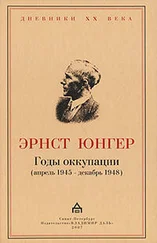The tree frogs and the sound of scythes being sharpened that makes them break into their choral song.
“ Der wollte auf der Geige reiten ” [He wanted to ride on the fiddle]—an expression meant to describe an arrogant person.
With the president in the evening. Here in France, fifty thousand people have died by aerial bombs during these Pentecost holidays. One reason is that a crowded train on its way to the Maisons-Laffitte racetrack was hit.
The president told me about a corporal, who is eager to serve on firing squads. He generally aims at the heart, but if he does not like the man to be executed, then he aims for the head, causing it to shatter. It is a subhuman trait to want to disfigure, to want to rob another person of his face.
I wonder which ones he aims at in this way. Probably the prisoners who come closest to the concept of human being—those who are successful, kind, or well-bred.
“Soldiers, aim for the heart, spare the face,” shouted Murat when he stepped up to the wall.
Incidentally, the day before yesterday, a twenty-six-year-old captain was executed, the son of a shipowner from Stettin. The reason given was that he said he wished a bomb would hit headquarters. A Frenchman from the region of La Val reported him.
PARIS, 30 MAY 1944
Visited Madame Didier in the afternoon. Conversation with her nephew, a child of five who was very nice. The little boy had recently been taken along to mass for the first time, where he saw the distribution of the sacrament. When asked what the priest had done: “ Il a distribué des vitamins à tout le monde ” [He handed out vitamins to everyone].
VAUX-LES-CERNAY, 31 MAY 1944
With the commander-in-chief in Vaux. Despite the stifling heat, we lit a fire to freshen the air. In addition to the general, Professors Krüger, Weniger, and Baumgart sat around the fire.
Generals are mostly energetic and stupid, which means they have a kind of active and calculating intelligence that any one of the best telephone operators possesses, and yet the masses pay mindless homage to them. Or they are educated, which diminishes the brutality that is part of their craft. There is always a flaw somewhere, either in their willpower or their sense of control. Very rarely is there a union of energy and education, as in the likes of Caesar and Sulla, or as we saw in our own age in Scharnhorst and Prince Eugene. For this reason, generals are mostly stooges for hire.
Then there is Heinrich von Stülpnagel who is called “the blond Stülpnagel” to distinguish him from other generals in this old military dynasty. He exhibits princely qualities befitting his proconsular station. These include his appreciation of peace and quiet, of leisure, and of the society of a small intellectual circle. All this contrasts with the workings that are otherwise found in the higher echelons of the staff. His aristocratic character tends to judge people by their minds. His life suggests that of a scientist, particularly in the way he acquired his comprehensive erudition during long periods of convalescence. He seeks out mathematicians and philosophers, and on the subject of history, he is fascinated with ancient Byzantium. Yet, one may say that as a strategist he was a good leader; as a statesman a good negotiator; and as a politician someone who never lost sight of our situation. All this makes it understandable that he has been an opponent of Kniébolo since the very beginning. Yet I notice clearly from one of his repeated gestures that he is tired: With his left hand he tends to rub his back, as if supporting it or keeping his posture erect. At the same time his face bears a worried expression.
Discussion about the Stoics and their premise: “In certain situations leaving one’s life is the duty of the capable man.” It looks as though the general carries on a private correspondence with his wife in which they discuss this and other topics of ethics.
Started reading Herman Menge’s translation of the New Testament, which Pastor Damrath gave me as a present.
Browsed some more in Georges Migot’s Essais pour une Esthétique Générale [ Essays Toward a General Esthetic ], a small volume where I noticed several observations about symmetry. This is a topic I have been thinking about more often over the past months. The author attributes to the Egyptians a tendency to asymmetry and cites their preference for heads in profile as evidence. Mirror imagery in art corresponds to repetition in music. The need for symmetry is apparently a subordinate trait. This means it applies more readily to the form than the content, like those related parts in painting where the size of the canvas, the frame, and in some cases, even the subject matter could correlate with each other but not the actual execution. Incidentally, the marginal notations are not especially precise. Symmetry is an immense topic. When I have the leisure time, I’d like to try to work my way into it via two paths—specifically, studying the relationship to free will and to the erotic sphere. An examination of insects and a description of a hermaphrodite butterflies gave me the idea.
PARIS, 31 MAY 1944
Before returning, I swam in the lake and then went hunting for subtiles . This spring I have again fallen prey to this passion.
Had breakfast with Madame Didier. She put the final touches on the head and then wrapped it in damp cloths to store it in the cellar, since she is traveling to the mountains to visit Hendrik de Man.
Concerning the style of engineers: Entscheidung [decision, determination] becomes Entscheid [decree, decision], which means first, that it turns it crudely into a masculine noun, and second, that the meaning is shifted from a connotation of deep consideration to the superficial, willful present.
PARIS, 1 JUNE 1944
Visited Florence at noon. After we had eaten, had a brief conversation with Jules Sauerwein, who had arrived from Lisbon. We discussed the possibility of peace and what form it could take.
In the evening had a discussion with the president and a Captain Uckel about Stalingrad. It seems that teams of cameramen from a propaganda unit were filming until the final hours. The films fell into the hands of the Russians and are supposedly being shown as part of Swedish newsreels. A portion of the grim events takes place in a tractor factory where General Strecker blew himself up along with his staff. You can see their preparations and watch the camera teams, who are not on the staff, leave the building before the huge explosion. This urge to record the final moments has something robotic about it and expresses a kind of technological reflex, like those twitching frogs’ legs in Galvani’s experiment. [158] Luigi Galvani, professor of anatomy at the University of Bologna after 1775, induced muscular contractions by attaching electrodes to laboratory specimens.
There is a scientific aspect to this as well. These are not monuments like those we leave to posterity or build to gods, be they only in the form of a cross hastily tied from willow twigs—these are, rather, documents by mortals for mortals, and mortals alone. How terrifying and real is the Eternal Return in its most lugubrious form: Again and again, this dying in an icy region is monotonously repeated. It is demonically conjured up without refinement, without splendor, and without solace. Where is the glory in any of this?
The captain [Uckel] thought the films should have been destroyed—but to what end? These are just reports from workers to other workers.
Then, concerning photography in general. On this subject, the president talked about a scene he had personally witnessed in Dreesen’s Hotel near Godesberg. As Kniébolo was coming down the steps, he was greeted in the foyer by a little girl, who approached him to present a bouquet. He leaned down to receive this and to touch the child on her cheek, and at the same time turned his head a bit to the side, calling out sharply, “Photograph!”
Читать дальше










![Эрнст Юнгер - Стеклянные пчелы [litres]](/books/410842/ernst-yunger-steklyannye-pchely-litres-thumb.webp)
